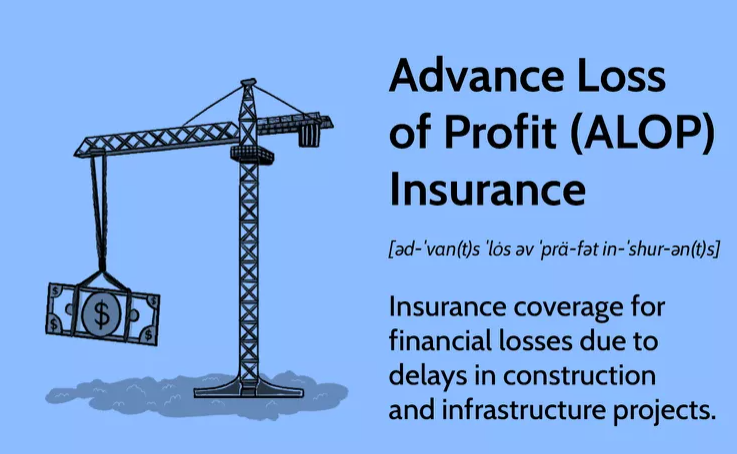In the realm of risk management and business insurance, Advance Loss of Profit (ALOP) insurance plays a crucial role for companies that face the potential for revenue loss due to unforeseen interruptions. Whether it’s due to natural disasters, machinery breakdowns, or any other disruptive events, ALOP insurance provides businesses with a financial safety net, ensuring they can weather storms and maintain operational continuity. This article delves into what ALOP insurance is, how it functions, and why it is vital for businesses today.

Understanding ALOP Insurance
Advance Loss of Profit insurance is a specialized type of insurance designed to cover the loss of income that a business may suffer due to an insured event. Unlike traditional property insurance, which focuses on physical assets, ALOP insurance is centered around revenue generation. It compensates businesses for the income they would have earned had the loss not occurred, thereby helping them maintain their financial stability during recovery periods.
Key Features of ALOP Insurance
- Coverage Period: ALOP insurance typically covers a specified period, which can range from a few months to a year, depending on the policy. The coverage period often begins after the insured event occurs, giving the business time to resume operations.
- Indemnity Limits: The amount of coverage available under ALOP insurance is determined by the insured’s projected profits. Businesses must carefully evaluate their revenue streams to ensure that the indemnity limit is adequate to cover potential losses.
- Triggering Events: ALOP policies specify the events that will trigger coverage. Common triggers include natural disasters (such as earthquakes and floods), fire, theft, or any operational disruptions that lead to business interruption.
- Exclusions: Like any insurance policy, ALOP insurance has exclusions. Businesses must be aware of what is not covered, which can include specific types of damage or losses due to negligence.
How ALOP Insurance Works
The process of obtaining and utilizing ALOP insurance involves several key steps:
1. Risk Assessment
Before purchasing ALOP insurance, businesses must conduct a thorough risk assessment. This involves identifying potential risks that could disrupt operations and estimating the financial impact of those risks. This assessment informs the type of coverage required and the appropriate indemnity limits.
2. Policy Acquisition
Once the risk assessment is complete, businesses can seek ALOP insurance from insurance providers. It is advisable to work with a broker who specializes in commercial insurance to ensure that the policy is tailored to the specific needs of the business. Key factors in policy negotiations include coverage limits, premium costs, and any specific clauses or exclusions.
3. Triggering the Policy
In the event of a loss, the insured business must notify the insurance company as soon as possible. The insurer will conduct an investigation to determine the cause of the loss and verify the claim. This often involves providing documentation, such as financial statements, to substantiate the claim for lost profits.
4. Claim Settlement
Once the claim is approved, the insurer will compensate the business for the calculated loss of profit during the coverage period. This compensation allows businesses to manage ongoing expenses, such as payroll, rent, and other operational costs, even while they are unable to generate revenue.
5. Resuming Operations
With the financial support from ALOP insurance, businesses can focus on restoring operations. The goal is to return to normalcy as quickly as possible, minimizing the duration of the income loss.
Benefits of ALOP Insurance
Investing in ALOP insurance offers several advantages for businesses:
1. Financial Security
One of the most significant benefits of ALOP insurance is the financial protection it provides. Businesses can avoid severe financial strain during challenging times, ensuring they have the resources to pay bills and meet obligations.
2. Business Continuity
ALOP insurance helps ensure that businesses can maintain operations during recovery periods. This continuity is crucial for retaining customer trust and market position.
3. Risk Management
Having ALOP insurance is a vital part of an overall risk management strategy. It allows businesses to be proactive about potential disruptions, enabling them to focus on growth and innovation rather than solely on risk mitigation.
4. Attracting Investors
For businesses seeking investment, having comprehensive insurance coverage, including ALOP, can enhance credibility. Investors are more likely to invest in companies that demonstrate a robust risk management framework.
Industries That Benefit from ALOP Insurance
While ALOP insurance can be advantageous for any business, certain industries particularly benefit from it:
- Manufacturing: Disruptions in production can lead to significant revenue losses, making ALOP insurance crucial for manufacturers.
- Retail: Retailers face income losses during events such as natural disasters or store closures, making ALOP insurance a wise investment.
- Hospitality: Hotels and restaurants often suffer from reduced income during events that disrupt customer flow, highlighting the need for ALOP coverage.
- Construction: Construction projects can be delayed due to weather conditions or accidents, making ALOP insurance beneficial for contractors.
Conclusion
Advance Loss of Profit insurance is an essential tool for businesses looking to safeguard their financial health against unexpected disruptions. By understanding its features, how it works, and the benefits it offers, businesses can make informed decisions about incorporating ALOP insurance into their risk management strategies. In an increasingly unpredictable world, ALOP insurance stands as a crucial safeguard, ensuring that businesses can not only survive disruptions but thrive in the long term. Investing in this coverage is not just a precaution; it is a proactive measure towards sustainable growth and resilience.








